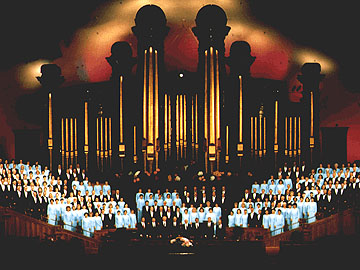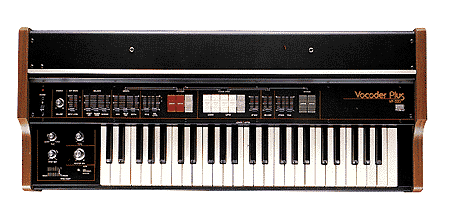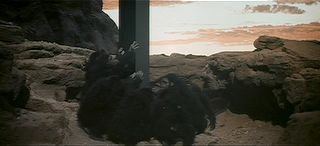Choir Sounds Without Samples

The Inspiration
The Roland VP-330 Vocoder Plus

I have one of these. It's a really great keyboard. In addition to a great vocoder and analog strings, it has male and female
choir sounds generated by running regular analog waveforms through formant bandpass
filters and chorusing the output. These choir sounds have been used on recordings by
many artists including Vangelis, who used them heavily in the soundtracks of Chariots
of Fire (beginning of Eric's Theme) and Blade Runner (unicorn dream sequence in Director's Cut).
Below are some patches I created using a
similar technique.
I did a lot of research about formant frequencies and tried values from several different charts in books that produced very bad results. Finally I found this chart of formant frequencies posted by Ric Miller in the archives of the Analogue Heaven Mailing List. These values sound great! I have developed patches around both the "Ahhh" and "Eeeee" values for men, women and children. The child values produce great boys choir sounds.
To the formant frequency chart I have added the note values for each frequency calculated with the wonderful converter program on this web site. On many synths the values of the filter cutoff are measured in meaningless units from 0-100 or some other arbitrary range. In these cases it is necessary to tune the filter by ear by playing the note at the desired frequency, cranking the resonance on filter as high as it will go, and moving the filter until it is right on top of the note you are playing. You know this has happened because the sound reaches maximum loudness and probably distorts as well. Then turn down the resonance until you like the sound. This is how I tuned these choir sounds on the JD-800. Also, you must set the filters so they do not follow the keyboard notes AT ALL, or velocity or anything else.
The Chart
(All values are rounded to the nearest half step.)
Speaker F3 F2 F1
------------------------------------------------
IY (beet)
Man 3010 = F#7 2290 = D7 270 = C#4
Woman 3310 = G#7 2790 = F7 310 = D#4
Child 3730 = A#7 3200 = G7 370 = F#4
IH (bit)
Man 2550 = D#7 1990 = B6 390 = G4
Woman 3070 = G7 2480 = D#7 430 = A4
Child 3600 = A7 2730 = F7 530 = C5
EH (bet)
Man 2480 = D#7 1840 = A#6 530 = C5
Woman 2990 = F#7 2330 = D7 610 = D#5
Child 3570 = A7 2610 = E7 690 = F5
AE (bat)
Man 2410 = D7 1720 = A6 660 = E5
Woman 2850 = F7 2050 = C7 860 = A5
Child 3320 = G#7 2320 = D7 1010 = B5
AA (hot)
Man 2440 = D#7 1090 = C#6 730 = F#5
Woman 2810 = F7 1220 = D#6 850 = G#5
Child 3170 = G7 1370 = F6 1030 = C6
AO (caught)
Man 2410 = D7 840 = A5 570 = C#5
Woman 2710 = E7 920 = A#5 590 = D5
Child 3180 = G7 1060 = C6 680 = F5
=
UH (full)
Man 2240 = C#7 1020 = C6 440 = A4
Woman 2680 = E7 1160 = D6 470 = A#4
Child 3310 = G#7 1410 = F6 560 = C#5
=
UW (good)
Man 2240 = C#7 870 = A5 300 = D4
Woman 2670 = E7 950 = A#5 370 = F#4
Child 3260 = G#7 1170 = D6 430 = A4
Patch Architecture
For creating patches based on these values, ideally you want an architecture like this:
+-------+ +---+
+---->| BPF 1 +---->| M |
| +-------+ | |
| | I |
| +-------+ | | +-----+ +--------+
Pulse wave osc ---+---->| BPF 2 +---->| X +--->| VCA +-->| Chorus +--->
(pick best | +-------+ | | +-----+ +--------+
sounding fixed | | E |
duty cycle) | +-------+ | |
+---->| BPF 3 +---->| R |
+-------+ +---+
Whatever software or synth you are using, the chorus effect at the end is vitally important for realism. If you turn the chorus off on the VP-330, the illusion of human voices TOTALLY disappears. The chorus units on the VP-330 are very complex, but I have not studied them in detail. Regular chorus effects seem to work ok on other synths.
Roland JD-800 Patches
On the JD-800, it's not possible to implement the ideal architecture, but you can do this instead:
Tone +---------+ +-------+ +-----+ +---+
A | Pls osc +-->| BPF 1 +-->| VCA +-->| M |
+---------+ +-------+ +-----+ | |
| I |
Tone +---------+ +-------+ +-----+ | | +--------+
B | Pls osc +-->| BPF 2 +-->| VCA +-->| X +-->| Chorus +--->
+---------+ +-------+ +-----+ | | +--------+
| E |
Tone +---------+ +-------+ +-----+ | |
C | Pls osc +-->| BPF 3 +-->| VCA +-->| R |
+---------+ +-------+ +-----+ +---+
Here are sound clips of my JD-800 patches using the above formant values:
The "Eee" sounds can be used in combination with the sustain pedal
and the "Pitch Random" slider to produce
Ligeti-like choir effects:
Hear it: (486K mp3)

My JD-800 Page
Here is a ZIP containing a syx file with all my JD-800 choir sounds: (1K ZIP).
I used the JD-800 Patch Organizer written by Laurent Lecatelier-Dudec, which can be downloaded from Oliver Ganz's page.


